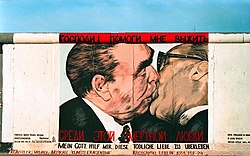
The Berlin Wall was the site of a large volume of artwork during its existence. Its highly contentious nature made it a popular place of political and cultural expression. After its reconstruction in the 1980s, graffiting on the wall became popular for artists worldwide and the art made it a common tourist destination. Only the West Berlin side of the wall had artwork, as citizens of East Berlin were not allowed to get close enough to the wall to paint on it.
Contents
One of the first artists to paint on the wall was Thierry Noir, who sought to express the emotions surrounding its presence. [2] It was one of the largest canvases in the world, and much of the artwork was not claimed by artists. Almost all of the wall has been removed and it only exists in places such as Potsdamer Platz, the East Side Gallery, and Bernauer Straße; many segments are now exhibited in other countries; see List of Berlin Wall segments.







